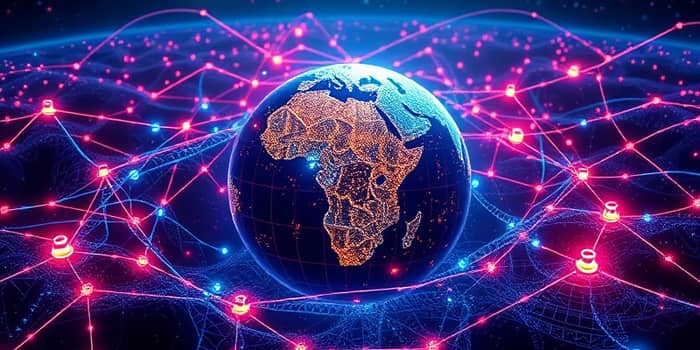As the internet evolves, a new paradigm is emerging that promises to redistribute power, ownership, and value back to individuals. At its core, Web3 aims to redefine our digital experiences through decentralization, transparency, and user sovereignty.
Historical Evolution: From Web1 to Web3
The story of the internet began with Web1, characterized by static, read-only websites of the 1990s. Users had limited interaction and consumed content without contributing. This era laid the foundation for connectivity but offered minimal engagement.
With the advent of Web2, the landscape shifted to interactive, social platforms, user-generated content. Services like search engines and social networks flourished, driven by centralized companies that owned and monetized user data. While this phase unlocked collaboration and communication, it concentrated control in the hands of a few tech giants.
Now, Web3 arises as the proposed next phase—a vision of a decentralized, community-controlled internet experiences where peer-to-peer interactions and blockchain innovation replace centralized intermediaries.
Core Technologies and Features
Web3’s foundation rests on several transformative technologies, each playing a distinct role in reshaping online ecosystems and enabling trustless interactions.
- Decentralization: Data is distributed across networks rather than stored by single entities.
- Blockchain: Utilizes public, immutable digital ledgers for data storage to ensure transparency and security.
- Ownership and Control: Users hold cryptographic keys to their identities, assets, and personal data.
- Trustlessness: Smart contracts automate agreements, eliminating the need for central authorities.
- Interoperability: Assets and information flow seamlessly across platforms without silo constraints.
- Semantic Web & AI: Machines understand context, improving search and personalized experiences.
- 3D Graphics & Ubiquity: Immersive AR/VR content accessible from any device.
- Privacy & Security: Self-sovereign identity and encryption reduce breach risks.
Web2 vs Web3: A Side-by-Side Look
Comparing the traditional internet to its decentralized successor highlights fundamental shifts in governance, security, and user empowerment.
Market Data and Growth Projections
Web3 adoption is accelerating with impressive growth metrics and financial activity. The global blockchain market is projected to soar from $7.4 billion in 2022 to a staggering $163.83 billion by 2029. This expansion reflects surging investments in decentralized applications and infrastructure.
In the DeFi sector alone, over $80 billion in assets are locked in protocols as of 2025. Meanwhile, more than 50 million crypto wallets serve users worldwide, signaling broader participation and trust in decentralized finance solutions.
Key Use Cases and Applications
From finance to entertainment, Web3 is revolutionizing industries with innovative applications:
- Decentralized Finance (DeFi): Peer-to-peer lending, borrowing, and trading without banks.
- Digital Art & Collectibles: NFTs establishing verifiable ownership of unique assets.
- Decentralized Autonomous Organizations (DAOs): Community-governed projects and funds.
- Gaming: Play-to-earn models and interoperable in-game assets.
- Supply Chain: Transparent traceability and product authentication.
- Self-Sovereign Identity: Portable, user-controlled digital identities.
Benefits Driving the Shift
Web3 brings numerous advantages that empower individuals and foster innovation. By returning control to users, it enables new economic models such as token economies and microtransactions, where data itself becomes a personal asset. Transparency is elevated, as every transaction is verifiable on public ledgers, reducing fraud and corruption.
Moreover, borderless networks offer more equitable access to services, bypassing geographic and financial barriers. This democratization of technology holds promise for underserved communities and emerging markets.
Challenges on the Path Forward
Despite its potential, Web3 faces significant obstacles that must be addressed:
- Scalability: Many blockchains struggle with speed and cost-efficiency under heavy loads.
- User Experience: Managing wallets, private keys, and navigating dApps remains complex.
- Regulatory Uncertainty: Laws around crypto, data sovereignty, and token offerings are still evolving.
- Energy Consumption: Proof-of-work networks demand high power, though shifts to proof-of-stake are underway.
- Fragmentation: Incompatible protocols hinder seamless interaction across networks.
Envisioning the Future of Web3
Looking ahead, the integration of AI, machine learning, and IoT with decentralized infrastructure will unlock truly intelligent, context-aware services. Developers are creating permissionless dApps that break free from existing gatekeepers, fostering an ecosystem driven by community governance and innovation.
By embracing this evolution, we can cultivate a digital realm where transparency, security, and personal agency are the norm. The transformative journey of Web3 carries the potential for a more equitable digital landscape, inviting everyone to participate in shaping the next chapter of the internet.
References
- https://aws.amazon.com/what-is/web3/
- https://getkoyn.com/blog/web3-vs-traditional-internet-what-you-should-know
- https://content.expert.ai/blog/web-3-0/
- https://moldstud.com/articles/p-how-does-web3-differ-from-traditional-web-development
- https://www.simplilearn.com/tutorials/blockchain-tutorial/what-is-web-3-0
- https://www.edgeofnft.com/podcasts/exploring-the-next-gen-internet
- https://www.mckinsey.com/featured-insights/mckinsey-explainers/what-is-web3
- https://www.tokenmetrics.com/blog/understanding-web3-differs-todays-internet










